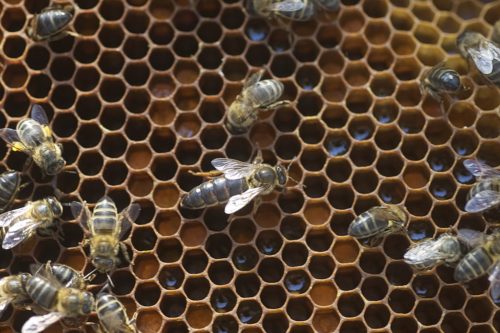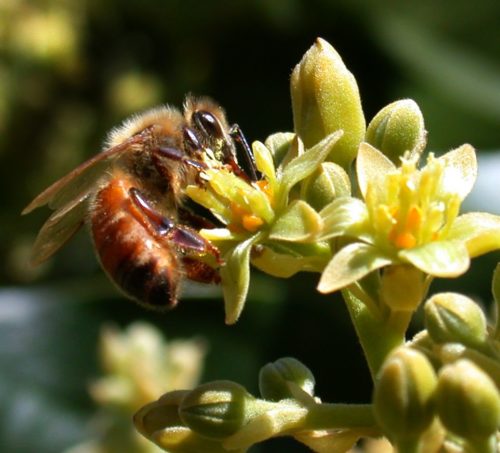New York, New York —(Map)
A swarm of 25,000 bees landed on a hot dog stand in Times Square in New York City on Tuesday. The bees caused a lot of excitement, and even backed up traffic before the police were able to vacuum up the bees and take them away.
Honeybees live in large groups, called “colonies”. A colony lives in a nest, often called a hive. Each colony has a queen, who lays the eggs for the colony.

In the spring, the queen and half of the bees may swarm to find a new nest.
(Source: Piscisgate, from Wikimedia Commons.)
From time to time, usually in the spring, over half of the bees may leave the nest in a “swarm”. Swarming bees are trying to keep the colony going, by splitting up. During the swarm, the bees are looking for a new place for their next nest. When they leave the nest, the bees all wait in one place while scouts look for the best place for the new nest.
On Tuesday, the bees started swarming because of the heat. They needed to find a cooler place for their nest.
The heat on Tuesday made the bees swarm.
They were looking for a cooler place for their nest.
Insane swarm of bees outside my office #TimesSquare #BeesInTheSquare pic.twitter.com/zZpeCmctOK
— AJM (@ajm510) August 28, 2018
While the scout bees were out looking, all the other bees flew to a brightly colored umbrella on a hot dog stand in the middle of New York City. Police soon closed off the area, including part of one street.
The New York City Police Department (NYPD) has two beekeepers. A beekeeper is someone who raises honeybees. Whenever there is a problem with bees in the city, these officers deal with it.
An NYPD beekeeper used a special vacuum to gently suck the bees up so that they could be moved safely to a hive somewhere else.
The NYPD has two beekeepers.
One of them used a special vacuum to collect the bees.
Bee-lieve it or not another swarm of ? ? has made its way to #TimesSquare! I guess the bees love the unbeelievable sights here! pic.twitter.com/pv1UiSdfik
— NYPDTimesSquare (@NYPDTimesSquare) August 28, 2018
When most people think of bees, they probably don’t think of a place like New York City. But more and more people are raising bees in cities.
Honeybees have been dying in great numbers around the world since 2007. Last year alone, beekeepers in the US lost about 40% of their colonies.
Scientists still do not know why the bee colonies are dying. Many scientists believe it has to do with insecticides – chemicals that farmers put on their fields to kill insects. Some of these insecticides are now against the law in Europe.

This bee is pollinating an avocado flower.
(Source: Andrew Mandemaker/Bff, via Wikimedia Commons.)
This is more important than just bees dying. Humans count on bees to help grow plants, such as flowers, trees, and crops (the plants farmers grow).
When bees visit flowers, they collect pollen – a yellow powder in the center of most flowers. If bees didn’t bring pollen from one flower to another, many of these plants could not grow fruits or vegetables.
The drop in the numbers of honeybees has some farmers so worried, that they are starting to use other kinds of bees to pollinate their crops.

This rooftop hive in Milwaukee is used to teach new beekeepers.
(Source: Bradley James, from Wikimedia Commons.)
In cities, some people have responded to the loss of bees by starting to raise their own bees. Rooftop hives are becoming more common. Some people do it because they want to help the environment. Others do it as a hobby or for the honey. A hive can produce about 55 pounds (25 kilos) of honey each year.
But if the hive gets too hot in the summer…the bees might have to swarm.
Credit for front page image of swarming bees:
(Source: Sid Mosdell, via Wikimedia Commons.)
😕
This map has not been loaded because of your cookie choices. To view the content, you can accept 'Non-necessary' cookies.
